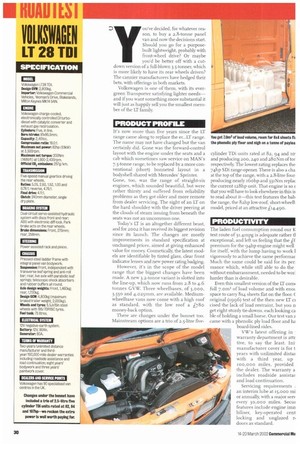VOLKSWAGEN LT20
Page 28

Page 30

If you've noticed an error in this article please click here to report it so we can fix it.
IPRICE AS TESTED: £17,585 (ex-YAT)*. ENGINE: 2.5 litres, 82hp (61kW). GVW: 2,800kg. PAYLOAD: 983kg. FUEL CONSUMPTION (laden): 31.4mpg (9.01it/100km)._ * Includes basic vehicle. 114,490: air conditioning 1900: rev counter, £85; central locking, £265; electric windows, £215: electric mirrors. £140; rear step, £85; headlamp washers, £200: phenolic ply load floor, £270; hardboard load space lining, £95: dual airbags, £650; upgraded Isringhausen driver's seat, £190.
When you're competing in the van market the secret is to offer exactly the vehicle a potential customer needs. Volkswagen aims to do that with two ranges: the evergreen Transporter and, when you need to carry that bit more, the LT. We've driven the baby of the LT family, fresh from a mild facelift, to find out how this old trouper is standing the test of time. If you tend to carry more bulk than weight, put this one on your shortlist.
:.‘ ou've decided, for whatever rea
son, to buy a 2.8-tonne panel van and now the decisions start. Should you go for a purposebuilt lightweight, probably with front-wheel drive? Or maybe you'd be better off with a cut down version of a full-blown 3.5-tonner, which i is more likely to have its rear wheels driven?
The cannier manufacturers have hedged their bets, with offerings in both markets.
Volkswagen is one of them, with its evergreen Transporter satisfying lighter needs— and if you want something more substantial it will just as happily sell you the smallest member of the IT family.
PRODUCT PROFILE
It's now more than five years since the LT range came along to replace the er...LT range. The name may not have changed but the van certainly did. Gone was the forward-control layout with the engine under the seats and a cab which sonietimes saw service on MAN's 7.5-tonne range, to be replaced by a more conventional (short) bonneted layout in a bodyshell shared with Mercedes' Sprinter. Gone, too, was the range of straight-six engines, which sounded beautiful, but were rather thirsty and suffered from reliability problems as they got older and more remote from dealer servicing. The sight of an LT on the hard shoulder with the driver peering at the clouds of steam issuing from beneath the seats was not an uncommon one.
Today's LT is an altogether different beast, and for 2002 it has received its biggest revision since its launch. The changes are mostly improvements in standard specification at unchanged prices, aimed at giving enhanced value for money. Cosmetically, the latest models are identifiable by tinted glass, clear front indicator lenses and new power rating badging.
However, it's in the scope of the model range that the biggest changes have been made. A new 3.2-tonne variant is slotted into the line-up, which now runs from 2.8 to 4.6 tonnes GVW. Three wheelbases, of 3,000, 3,550 and 4,025mm, are available. Mediumwheelbase vans now come with a high roof as standard, with the low roof a £780 money-back option.
There are changes under the bonnet too. Mainstream options are a trio of 2.5-litre five
cylinder TDi units rated at 82, 94 and no and producing 200,240 and 280Nm of tor respectively. The lowest rating replaces the 74hp SDi range-opener. There is also a cha at the top of the range, with a 2.8-litre four producing nearly i6ohp and 331Nm replac the current 128hp unit. That engine is so that you will have to look elsewhere in this is to read about it—this test features the bab the range, the 82hp low-roof, short-wheelt model, priced at an attractive £14,49o.
PRODUCTIVITY
The laden fuel consumption round our K test route of 31.4mpg is adequate rather tl exceptional, and left us feeling that the Lf premium for the 94hp engine might well for itself, with the lump having to work I vigorously to achieve the same performar Much the same could be said for its per mance which, while still able to do the without embarrassment, needed to be wor: harder than is desirable.
Even this smallest version of the LT corm full 7.om5 of load volume and with enoc space to carry 8x4 sheets flat on the floor. ( original (1996) test of the then new LT ct cised the lack of load restraint, but you n get eight sturdy tie-downs, each looking ca ble of holding a small horse. Our test van a came with a phenolic ply load floor and ha board-lined sides.
VW's latest offering in warranty department is attr tive, to say the least. manufacturer cover is for t years with unlimited distat with a third year, up roo,000 miles, provided the dealer. The warranty a includes roadside assistar and load continuation.
Servicing requirements an interim lube at 15,000 ml or annually, with a major serv every 30,000 miles. Secut features include engine imn biliser, key-operated cent locking and unglazed ri doors as standard.
















































































































































